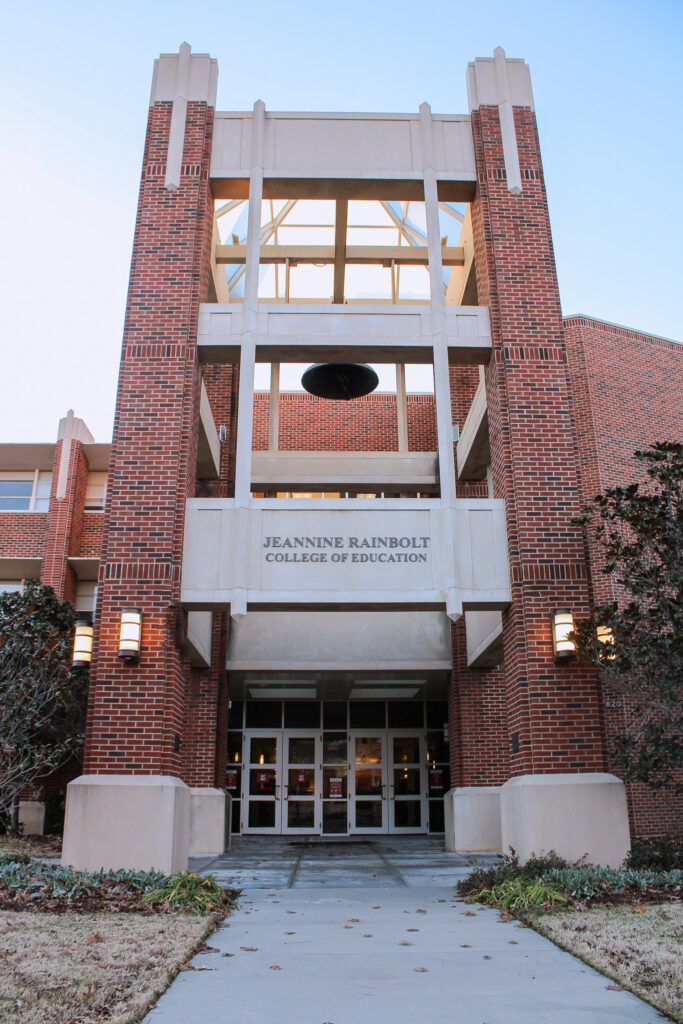The University of Oklahoma Prepares the Next Generation of Teachers
Current education-major students gear up for the classroom during the Oklahoma teacher shortage.
Sitting in the Jeannine Rainbolt College of Education lecture halls, students at the University of Oklahoma prepare for a career in education. As Oklahoma experiences a present-day teacher shortage, the public turns towards the new generation of educators to advocate for the quality of education. The question that many students and educators ask is what Oklahoma will look like in the years to come.
The Oklahoma Education Association ranked Oklahoma 34th in the nation for teacher salary. Going further, OEA reported that the average Oklahoma teacher earned $54,762 in 2020-2021. As a result of low pay, collegiate students pursuing a career in education remind themselves of the why behind their passion for teaching, even with low pay.
Sheridan Baker, majoring in education at the University of Oklahoma, discusses her desire to become a teacher, especially during the present-day teacher shortage in Oklahoma. Baker details her emotions as she takes on her last semester in the spring before graduating and becoming a teacher.
Sydney Young, a senior at the University of Oklahoma studying education, detailed how she remains focused on the reason she chose to become a teacher.
“[Education] is a tough industry in need of a lot of reshaping. The pay needs a serious increase everywhere, but especially in Oklahoma. Teachers do way more work than what their paycheck reflects. But, I keep the students in mind and what they deserve to get out of their time in school. When days get tough, I need to keep in mind why I chose this career in the first place. There will be unruly students, parents, or admin, but it is important to keep in mind the passion and love for this career path that led me to take it in the first place,” Young said.
Colleges across the United States experience a decline in collegiate graduates with an education degree. Pew Research Center analyst Kathrine Schaeffer reported that U.S. colleges and universities had 80,057 students earn education bachelor degrees in 2019-20, which showed a 19% decline from the number of undergraduates with a bachelor’s degree in education. A drop in the amount of individuals who pursue an educational degree impacts the quality of education as the pool of qualified teachers diminishes.
With a decrease in students pursuing careers in education, the University of Oklahoma Jeannine Rainbolt College of Education gave its students the resources and hands-on experience to be successful in the classroom.

Kami Fryer, a junior majoring in education at the University of Oklahoma, spoke about the impact that the Jeannine Rainbolt College of Education has made on her life.
“The college of education at OU has been a very impactful experience. My professors have taught me what it is like to put my students first. When I first signed up to be a teacher, I thought they were going to teach me how to teach, and I feel like they are more focused on the well-being of the children. I believe knowing, and remembering your passion for students, makes teaching all worthwhile.”
Kami fryer, Junior at The University of Oklahoma
In order to prepare the next generation of educators for the classroom, students at the Jeannine Rainbolt College of Education were given internship opportunities to co-teach with a teacher at a local school in Norman, Oklahoma.
“I am currently student teaching which has been the biggest help in preparing me for this career. I work contract hours, plan lessons, work one on one with students, and even interact with admin and parents. I am so grateful for this opportunity because so much of this career is experience based. There is so much about teaching that can’t be learned in a textbook so I would say getting to be hands-on and in the field has been the biggest help in preparing me to become a teacher,” Young said.
In addition to the low annual salary and decline in the number of qualified teachers, the amount of money invested into each student in Oklahoma has declined. From the Oklahoma Policy Institute’s Child Well-Being Policy Analyst, Gabrielle Jacobi, wrote that Oklahoma spends $1,000-$2,000 less than New Mexico, Colorado, Kansas or Missouri. Specifically, the U.S. Department of Education found that Oklahoma spent between $9,000-$10,999 per pupil for the fiscal year 2020.
A higher spending per pupil in Oklahoma would allow school districts more funding to increase the quality of education. Even more, a proper education or a high-quality education builds the generations to come in the future.
Sheridan Baker, a senior studying elementary education at the University of Oklahoma, stated why there is a need to provide quality education for students.
“We need to increase better education for students because they are the future generation. Without better education, our future is going to crumble. These kids deserve an education that can prepare them and help them succeed in their life to come,” Baker said.


